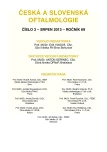Wet Form Age-Related Macular Degeneration Two Years Treatment Results Using Anti VEGF Drugs
Authors:
J. Studnička 1; E. Rencová 1; J. Dusová 1; J. Marak 1; M. Burova 1; P. Rozsíval 1; J. Jarkovský 2; V. Kandrnal
Authors‘ workplace:
Oční klinika LF UK a FN Hradec Králové, přednosta prof. MUDr. Pavel Rozsíval, CSc., FEBO
1; Institut biostatistiky a analýz, MU Brno, ředitel doc. RNDr. Ladislav Dušek, PhD.
2
Published in:
Čes. a slov. Oftal., 69, 2013, No. 3, p. 96-101
Category:
Original Article
Overview
Aim:
The aim of the study was to establish the efficacy of anti VEGF (Vascular Endothelial Growing Factor) drugs in the treatment of wet form ARMD (Age-Related Macular Degeneration) in everyday clinical practice in the Department of Ophthalmology, Faculty Hospital, Hradec Králové, Czech Republic, E.U., in patients registered in the Czech national registry AMADEUS.
Material and methods:
Retrospective study with 24 months follow-up period. In the group were evaluated 143 eyes of 140 patients, out of them were 77 women (65.8 %), of average age 73.09 (71.69 – 74.48) years, and 40 men (34.2 %) of average age 74 (58 – 85) years. All of the patients were completely examined before the beginning of the treatment; during the treatment were, except the standardized eye examination, in patients treated with ranibizumab the color fundus photography and Optical Coherence Tomography (OCT) with measuring of the central retinal thickness performed every three months at least. The patients treated by pegaptanib were examined every six weeks before the drug application. The fluorescence angiography (FA) was performed at the beginning of the treatment to establish the type and extension of the choroidal neovascularization and during the treatment in case of necessity to establish the activity of the choroidal neovascular membrane (CNV). The treatment by ranibizumab was in the regimen PRN (pro re nata), and pegaptanib was applied every six months during the first year with the follow-up evaluation of the findings. The treatment evaluations were performed at 12 and 24 months.
Results:
During the two years follow – up period, the authors noticed in patients treated with ranibizumab loss of 5.12 letters of ETDRS optotypes in case of mostly classical CNV, in occult CNV loss of 5.45 letters, and in minimally classical CNV loss of 2.83 letters. In three evaluated eyes with classical CNV in patients treated with pegaptanib we noticed after 2 years loss of 6.67 letters, in eleven eyes with occult CNV we established loss of 9.91 letters, and in two eyes with minimally classical CNV the average best-corrected visual acuity (BCVA) remained unchanged. The pegaptanib treatment results may be influenced by small number of evaluated patients. The visual acuity changes during the two years treatment were not statistically significant. We noticed the decrease of average CRT (central retinal thickness) in all types of CNV treated both with ranibizumab and pegaptanib after the two years follow up. To reach these results, an average of 5.51 applications of ranibizumab and 9 applications of pegaptanib during the two years were used.
Conclusion:
In the followed-up group we found, comparing to the natural course of neovascular form of ARMD, retarding of the BCVA decrease during the two years treatment with VEGF inhibitors in everyday clinical practice. Better results were achieved with ranibizumab treatment, however the differences were not statistically significant.
Key words:
age related macular degeneration, AMADEUS Czech national registry, ranibizumab, pegaptanib
Sources
1. Ferris III, FL., Fine, SL., Hyman, L.: Age-related macular degeneration and blindness due to neovascular maculopathy. Arch Ophthalmol, 102; 1984: 1640–2.
2. Fung, AE., Lalwani, GA., Rosenfeld, P. et al.: An optical coherence tomography-guided, variable dosing regimen with intravitreal ranibizumab (Lucentis) for neovascular age-related macular degeneration. Am J Ophthalmol, 143; 2007, 4: 566–83.
3. Gragoudas, ES., Adamis, AP., Cunningham, Jr., ET. et al.: Pegaptanib for neovascular age-related macular degeneration. N Engl J Med, 351; 2004: 2805–16.
4. Holz, FG., Amoaku, W., Donate, J. et al.: Safety and efficacy of a flexible dosing regimen of ranibizumab in neovascular age-related macular degeneration: the SUSTAIN study. Ophthalmology, 118; 2011, 4: 663–71.
5. Lowe, J., Araujo, J., Yang, J. et al.: Ranibizumab inhibits multiple forms of biologically active vascular endothelial growth factor in vitro and in vivo. Exp Eye Res, 85; 2007: 425–30.
6. Matušková, V., Kolář, P., Vysloužilová, D. et al.: Ranibizumab v léčbě vlhké formy VPMD – dvouleté výsledky léčby z registru AMADEUS. Čes Slov Oftal, 68, 2012; 5: 171–77.
7. Ng, EW., Shima, DT., Calias P. et al.: Pegaptanib, a targeted anti-VEGF aptamer for ocular vascular disease. Nat Rev Drug Discov, 5; 2006: 123–32.
8. Seddon, JM., Chen, CA.: The epidemiology of age-related macular degeneration. Int Ophthalmol Clin, 44; 2004: 17–39.
9. Wong, T., Chakravarthy, U., Klein, R. et al.: The natural history and prognosis of neovascular age-related macular degeneration. Ophthalmology, 115; 2008: 116–26.
Labels
OphthalmologyArticle was published in
Czech and Slovak Ophthalmology

2013 Issue 3
Most read in this issue
- Glaucoma Therapy – Current Overview of Data and Information
- New Methods of the Treatment of Retinal Dystrophies
- The Potential use of Honey in Ophthalmology
- Surgical Treatment of the Idiopatic Macular Hole – our Experience
